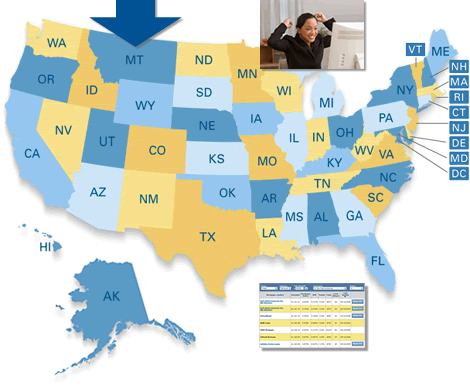Decoupling Finances: Is It Possible to Remove a Co-Signer from a Mortgage Without Refinancing?
Signing a mortgage is a commitment that extends beyond the realm of personal relationships and into the legal juncture of fiscal responsibility. As a co-signer, one takes on a critical role, guaranteeing payment of the loan should the primary borrower fail to make good on their obligations. This intertwining of liabilities creates a multidimensional bond of responsibility and reliance that each party – lender, primary borrower, and co-signer – must understand and respect. But life is fluid, circumstances change, and the question arises: Can you extricate someone's name from a mortgage, sever the legal ties without the often-onerous process of refinancing? This piece seeks to elucidate the possibilities and limitations of releasing a co-signer from the entanglements of mortgage responsibility without the need for restructuring the entire loan.
Divorce and Mortgage Responsibility
Navigating mortgage responsibility amidst marital separation can be a complex and emotionally charged process. When a couple decides to divorce, the division of financial obligations, including the mortgage, becomes a critical issue to resolve. Understanding how to handle the joint responsibility of a home loan during this transition is essential for both parties involved.
The Division of Financial Obligations During a Divorce
During a divorce, all marital assets and debts must be divided according to state laws. This typically involves determining who will be responsible for the mortgage payments going forward. If one party wishes to keep the property, they may need to explore options for removing the ex-spouse's name from the mortgage without refinancing. However, this can be a challenging process, often requiring negotiations and legal interventions.
- Legal Considerations: It's important to consult with a legal professional who can guide you on the implications of your divorce agreement and the potential impact on your mortgage arrangement.
- Financial Assessments: A thorough assessment of each individual's financial capability to maintain mortgage payments post-divorce is crucial in determining a fair division of debt obligations.
Finalizing a divorce decree that outlines who will be responsible for the mortgage and under what terms is an essential step in ensuring clarity and preventing future disputes over property and financial responsibilities.
Requirements for Removing a Name from a Mortgage
When it comes to altering the dynamic of a mortgage, knowledge is power. Understanding the prerequisites is essential for anyone wondering, can you remove someone's name from a mortgage without refinancing. Here are the key considerations:
Critically Analyzing Lender Terms and Conditions for Name Removal
Every mortgage lender has specific terms and conditions that govern the possibility of removing an individual's name from a mortgage. It is vital to review your mortgage agreement with close attention to clauses that pertain to modifications of the involved parties. Some lenders may permit alterations, whereas others strictly require refinancing to change the names on the mortgage.
Determining Eligibility Criteria Established by Lenders
The eligibility criteria for name removal can vary widely from one lender to another. Common qualifying factors include:
- A history of on-time mortgage payments
- Evidence that the remaining party can handle the mortgage independently
- The loan-to-value (LTV) ratio meeting the lender's guidelines
- No recent defaults or foreclosures on the property
Lenders will evaluate the borrower's financial stability and creditworthiness to ascertain if they are capable of shouldering the mortgage solo. If the remaining party does not meet these standards, lenders may not approve the removal of a co-borrower's name.
Understanding the Legal and Financial Implications of Name Removal from a Mortgage
Removing someone’s name from a mortgage is a decision that requires careful consideration of the legal and financial repercussions. When a name is removed from the mortgage, it does not only affect the ownership arrangements but can also have significant implications for the credit and financial standing of both parties involved.
Financial Status and Credit Implications
For the individual whose name is being removed, their financial obligation towards the mortgage loan is lifted, which may improve their debt-to-income ratio. However, this could potentially have adverse effects on their credit score due to changes in credit utilization. On the other hand, the remaining party will assume full responsibility for the mortgage, which may affect their ability to secure future loans due to a higher debt burden.
Interest Rates and Credit Obligations
Changes in interest rates can occur if the mortgage terms are altered during the name removal process. Sometimes, the lender may require a loan modification which could potentially result in a different interest rate that can either be higher or lower than the current rate. It's essential for the involved parties to fully understand the new terms and how these could impact the overall cost of the loan.
- Continued liability for the removed party if not properly executed
- Potential for increased financial burden on the sole mortgage holder due to loan assumptions
- Risk of unfavorable refinancing terms if not well-negotiated
Therefore, it’s crucial to seek advice from financial and legal professionals to navigate the complexities of name removal without refinancing and to protect the interests of all parties involved.
Equity Disbursement and Buyouts: Navigating Name Removal on Your Mortgage
Understanding home equity is crucial when considering the removal of someone's name from a mortgage without refinancing. Essentially, equity is the portion of the property that you truly own – it's the current market value of your home minus any outstanding mortgage balances. Equity can increase over time as you pay down your mortgage or if the property value appreciates.
Significance of Home Equity in Name Removal
When it comes to removing a name from a mortgage, home equity plays a pivotal role. If the person remaining on the mortgage can pay out the equity amount to the person being removed, this is commonly referred to as an equity disbursement. It's a financial settlement that compensates the departing individual for their share of the property's value.
The Buyout Process and Its Financial Implications
The buyout is a process where one party pays the other their share of the equity, allowing for a clean break from the mortgage loan. This process involves several key steps:
- Determining the home's current market value through appraisal or comparative market analysis.
- Calculating each party's share of the equity.
- Securing funds for the buyout, which might come from personal savings, a home equity loan, or a cash-out refinance by the remaining party.
The financial implications of a buyout are considerable. The party exiting the mortgage must understand the tax consequences and the impact on their personal finances, while the remaining party must ensure they can afford the new financial obligation.
In summary, while removing someone's name from a mortgage without refinancing involves complex considerations, equity disbursement and buyouts offer a viable pathway. It's imperative to consult with financial and legal professionals to navigate this process successfully.
Lender Approval Process for Name Removal
Removing a co-signer's name from a mortgage is a significant change that requires thorough lender approval. This process demands clear communication, substantial documentation, and compliance with the lender's requirements to ensure the mortgage's stability and legality. Below is a step-by-step guide to navigating this intricate procedure.
Step-by-Step Breakdown of Obtaining Lender Consent
- Request a Mortgage Review: Contact your lender and express your intent to remove a name from the mortgage. This will trigger an official mortgage review to assess the feasibility of the change.
- Submit Required Documentation: Provide all relevant forms and legal documents that the lender requires. This often includes financial statements, proof of income, and legal documents indicating the reason for the name change.
- Evaluation of Creditworthiness: The remaining party will be subjected to a credit check to ensure they are capable of sustaining the mortgage independently.
- Approval of Conditions: If the lender stipulates conditions such as maintaining a certain income level or credit score, these must be met and approved.
- Formal Agreement: Upon satisfying all requirements, you’ll execute a formal agreement detailing the terms of the name removal, which may include a novation or mortgage assumption if applicable.
Importance of Satisfying the Lender's Financial Requirements
It's crucial to understand that lenders emphasize financial stability. The removal of a co-signer's name from a mortgage alters the risk dynamics initially agreed upon. Therefore, the remaining borrower must demonstrate sufficient financial capacity to take on the full responsibility of the mortgage. Failure to meet these requirements often results in the denial of the application to alter the mortgage contract. It is imperative that individuals work closely with their lender to ensure a smooth transition that secures their housing and financial future.
Credit Score Considerations
When contemplating the removal of someone's name from a mortgage without refinancing, it’s crucial to bear in mind how such a move can impact credit scores. The process of name removal involves reassessing the loan's responsibility, which may be registered by credit bureaus and hence, reflected in the individuals' credit reports. Therefore, understanding the implications on credit scores is important for both parties involved.
How Credit Scores Are Affected During and After Name Removal
The credit score of the person whose name is being removed could potentially see a decline if the mortgage constituted a substantial part of their credit history. If the remaining borrower has a solid payment history and remains in good standing, their credit score may be less affected. However, potential risks arise if the remaining party defaults or encounters financial difficulties, negatively affecting their credit score due to increased debt-to-income ratios.
The Importance of Maintaining Good Credit in the Eyes of Lenders
Maintaining a strong credit score is paramount in the eyes of lenders, particularly if future borrowing is anticipated. A credit score is a testament to fiscal responsibility and is a major factor that lenders consider when determining the terms of a loan or whether to extend credit at all. Therefore, it is vital for both parties to preserve their credit standing throughout the process to ensure financial options remain open down the line.
- A higher credit score can result in better interest rates and loan terms.
- Regular monitoring of credit reports is advisable during and after the removal process.
- Ensuring all payments are made on time during the process can help mitigate negative impacts on credit scores.
Exploring Loan Assumption Options
Loan assumption is a less commonly known method for managing a mortgage when you need to remove someone's name from it. Essentially, loan assumption allows a third party to take over the remaining mortgage payments under the original loan terms. This option can be particularly useful during a property transfer, a divorce, or in situations where refinancing is neither desirable nor feasible.
Understanding Loan Assumption
When considering loan assumption, it is crucial to understand that not all mortgages are assumable. To pursue this option, both the lender holding the mortgage and the loan itself must permit assumptions. Typically, government loans like FHA, USDA, or VA loans offer assumability, but conventional loans may not. It is important to review your mortgage agreement or speak with your lender to verify if your loan qualifies for assumption.
Loan Assumption vs. Refinancing: A Comparative Analysis
The key difference between loan assumption and refinancing lies in the process and ownership change. With loan assumption, a new borrower assumes the existing mortgage, its interest rate, and the terms set originally. In contrast, refinancing involves paying off the existing mortgage and creating a new loan with potentially different terms and rates.
- Continuity of Terms: With assumption, the terms of the original loan, including the interest rate, remain the same, which can be advantageous if the existing rate is lower than current market rates.
- Cost Efficiency: Assumptions often incur lower costs compared to refinancing, as they avoid closing costs associated with taking out a new mortgage.
- Time-Saving: Assuming a loan can be a quicker process than refinancing, which involves a full loan application, property appraisal, and other time-consuming steps.
However, loan assumption also has its challenges. The assuming borrower must qualify and be approved by the lender, and they typically need to pay a fee. Moreover, the original borrower may still be held liable unless they obtain a release of liability from the lender. Both the current and prospective borrowers should weigh the advantages and drawbacks of loan assumption against the costs and benefits of refinancing to make an informed decision that aligns with their financial situation.
Exploring Alternative Solutions to Mortgage Refinancing
When it comes to releasing someone’s obligation from a mortgage without the need to refinance, there are a few creative approaches homeowners can consider. These alternatives not only may help in addressing mortgage liability but also can be aligned with the financial plans and capabilities of the involved parties. Here we discuss some of the potential options available.
Lump-Sum Payment
One viable alternative to refinancing is making a lump-sum payment towards the mortgage principal. This can significantly reduce the outstanding balance and may prompt lenders to consider removing a party's name from the mortgage. However, this option requires access to a substantial amount of capital and may not be feasible for everyone.
Mortgage Modification
A mortgage modification is another option where the terms of the original loan are altered, potentially allowing for the removal of a party’s name. This could involve extending the loan period, reducing the interest rate, or changing other terms that might make the lender agree to the name removal. It's important to communicate effectively with the lender to explore this possibility.
Adding a New Co-Signer
Introducing a new co-signer with a strong credit profile could provide the lender with the security needed to release the original co-signer from the mortgage. This solution can be particularly useful when one party wishes to retain the property but may not qualify to hold the mortgage independently.
- To consider this option, the new co-signer must be willing and able to accept the responsibilities associated with the mortgage.
- The lender's approval is mandatory in this process, which includes a thorough credit evaluation of the potential new co-signer.
It's essential to weigh the pros and cons of each alternative and consult with financial advisors or legal professionals before making a decision. These options, while potentially beneficial, come with their own set of implications and should be approached with due diligence.
Understanding Legal Documentation and Title Changes
Removing a person's name from a mortgage is a legal process that necessitates meticulous attention to the essential documents and procedures for adjusting title ownership. The pathway to achieving a name removal without refinancing involves navigating through a series of legal steps to ensure the transfer of property rights is conducted in full compliance with the law.
Essential Legal Documents for Name Removal
To start the process of name removal from a mortgage, certain legal documents must be prepared and filed. These documents may include, but are not limited to:
- A quitclaim deed or warranty deed to transfer property ownership
- A novation agreement to modify the parties responsible for the mortgage debt
- Release of liability forms to discharge the exiting party from future obligations
- Court orders, depending on your state and personal circumstances, such as a divorce decree
It is essential to consult with a real estate attorney to ensure that the correct documents are used and that they are prepared correctly.
The Title Ownership Alteration Process
Changing the title of a property to reflect the new ownership structure is a critical component of removing a name from a mortgage. The process typically involves:
- Recording the new deed with the appropriate government office
- Paying any necessary filing fees or transfer taxes
- Certifying that the mortgage is in good standing
- Obtaining lender's consent for the changes, where applicable
This step formally transfers ownership and protects the remaining owner's rights to the property. It is paramount that these changes comply with local and state real estate laws to avoid any future disputes or legal issues.
The ambit of legal documentation and title changes is complex and can vary significantly depending on the jurisdiction and specific circumstances. Professional legal advice is not just recommended, but often required to ensure the integrity of the process and to safeguard your financial interests.
Exploring Your Options for Mortgage Name Removal
Throughout this discussion, we've examined a variety of strategies for removing someone's name from a mortgage without refinancing. It's clear that while the process can be complex, involving both legal and financial nuances, there are feasible paths forward for those needing to make this significant change.
The key points to remember include understanding the full scope of co-signing responsibilities, navigating changes due to divorce, and being aware of the lender's requirements for name removal. Additionally, considerations around equity disbursement, buyouts, and the potential impact on your credit score must not be overlooked. For some, loan assumption may present a viable alternative to refinancing, while others may find solace in alternative solutions.
As you consider these options, remember to evaluate the long-term implications on both liability and financial planning. Moreover, the emotional complexities that accompany such changes demand thoughtful consideration and, often, the guidance of professionals.
While we have provided a comprehensive overview of the process, individual circumstances can vary greatly, and personalized advice is often crucial. Therefore, we encourage you to consult with qualified mortgage advisors who will understand the specifics of your situation and help you navigate the nuances of this transition.
Fannie Mae & Jumbo Mortgage Rates
Just One Click! = Current Rate Chart

Start by selecting your state
Refinancing: Selecting a Loan

- Mortgage Program Options
- Interest Only Mortgage
- 100% Mortgage Financing - No Down Payment
- Mortgage Rates Comparison
- Search for Mortgage Rates
- No Costs Mortgage Refinancing
- 2% Rule - Refinancing Mortgage
- Yield Spread Premium
- Prepayment Penalty - Mortgage Refinancing
- What is APR and how is it calculated?
- Private Mortgage Insurance - Refinancing
Moving Ahead With Your Refinance
Get the Updated and Improved Mortgage Rates App from ERATE.com
FREE Mortgage Rate WidgetsYour State's Rates or National Rates Get this Widget for any State you want


